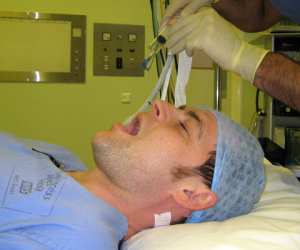

MedFriendly®


Extubation
Extubation means to remove a tube from a body
opening, organ, or structure. The term is often used to
describe the removal of a tube from the trachea
(windpipe), which is used to help people breathe when
the ability to breathe independently is impaired (for
example, due to a brain injury or during certain
surgeries). This type of tube is referred to as a
breathing tube or an endotracheal tube. The process of
placing such a tube into an opening, organ, or structure
of the body is known as intubation.
FEATURED BOOK: A Bedside Guide to Mechanical Ventilation
Removal of a breathing tube is done to help the person breathe on their own through
mechanical ventilation. Intubation and extubation are commonly associated with major
surgical procedures and comatose states caused by severe traumatic brain injuries. The
breathing tubes are in place when the patient is kept on the intensive care unit.
HOW ARE PATIENTS PREPARED FOR EXTUBATION?
Prior to being extubated, the patient is typically slowly or quickly weaned off of the
ventilator to make sure he/she can breathe adequately. The weaning process involves
the ventilator providing less breathing support over time. If the airway remains open and
the patient can keep it that way without choking, he/she will be ready for extubation.
There are extubation guidelines that exist for people who are considered low risk and
others who are considered to be at risk.
"Where Medical Information is Easy to Understand"™
Low risk means that it is expected but not guaranteed that the
patient will be able to be extubated without difficulty. At risk cases
are those in which there is concern that the patient may not be able
to maintain the airway due to risk factors in the airways or
elsewhere in the body, that the person may need to be re-intubated
and placed back on the ventilator, and that complications may occur
if this is needed.
WHAT HAPPENS DURING EXTUBATION?
At the point the patient is extubated, he/she is awake, can
cooperate with health care providers, and exert an adequate cough
strength (preferably on command).
During the extubation process, the patient is typically sat up so that any secretions can be suctioned out
of the mouth and breathing tube. This prevents secretions from getting into to the lungs and interfering with
breathing by increasing the choking risk. The breathing tube cuff is let down and deflated and the tube is
then removed at the peak of sustained inflation. When the patient exhales passively, it can help release
secretions and may reduce the chance of breathholding and spasms of the larynx. The larynx is an organ
located at the upper part of the windpipe that produces voice.
WHAT HAPPENS AFTER EXTUBATION?
After extubation, the patient remains closely monitored (e.g., oxygen saturation levels) to assess for any
problems in case a back-up plan needs to be implemented. Once it is clear that vital signs remain stable
and the person is breathing adequately, extubation will be considered a success.
In some cases, the person will remain extubated despite having difficulty breathing. Breathing difficulties
after extubation can happen for many reasons such as a lung infection, decreased oxygen storage, acute
(sudden) swelling of the airway, injury to the airway, muscle weakness, abnormal reflexes of the airway
and/or the larynx. Other complications that can result after extubation includes spasms of the bronchi
(small airways connected to the lungs) and spasms of the larynx. Spasms of the larynx can lead to
water enters the lung tissue and the air sacs in the lung).
Medications can be used to treat some of the problems with breathing that can result after extubation such
as antibiotics, inhaling medications in mists to improve lung functioning, suctioning, and physical therapy
to clear the lungs (typically via clapping on the back or chest). Non-invasive oxygen supplementation can
be provided through a nasal cannula (a small tube that goes slightly into the nostrils) to assist with
breathing so that the person does not need to be re-in tubated. However, this is only an option if the
breathing difficulty is relatively mild. A sore throat and throat harshness after extubation are normal due to
irritation from the breathing tube. These signs and symptoms are expected to be short-lived and can be
treated with throat lozenges.
DOES THE BREATHING TUBE REMAIN IF THE PATIENT IS DYING OR PASSES AWAY?
If it is clearly established that the patient is dying, the breathing tube will be removed to maintain the
personís dignity. However, if the patient dies, the airway remains in for the autopsy and removed
afterwards.
WHAT IS THE ORIGIN OF THE WORD, EXTUBATION?
Extubation comes from the Latin word "ex" meaning "out," and the Latin word "tuba" meaning "tube." Put
the words together and you have "tube out."















